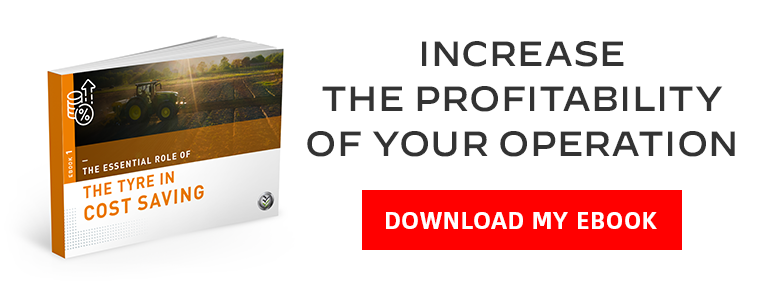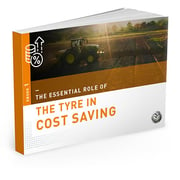If you do multiple trips by tractor between field, farm and the cooperative, the reliability of your tyres is crucial. We tend to concentrate too often on tyre performance in the fields, yet it is just as important to look at how they handle on the road. Agricultural tyres face very specific types of strain during braking or cornering and their capacity to keep a good grip and maintain optimal stability can make all the difference as far as safety is concerned.
What really happens when cornering? The tyres face a lot of torque, a redistribution of the load and a risk of heating up, which are all factors that can affect their lifespan and performance capacity. However, it is not always easy to recognise the signs of any potential defect. A tyre that loses adherence or becomes distorted when cornering can result in costly or even dangerous accidents.
In this article, we look into the factors that influence the reliability of your agricultural tyres on the road and more specifically during cornering. From the role that they play in road safety to what helps improve their road handling ability, as well as the best technological choices, you will discover the essential elements to take into account if you wish to avoid unpleasant surprises when driving.
1. How do your agricultural tyres fare during cornering?
Agricultural tyre behaviour during cornering is a complex phenomenon which depends on many factors, such as the strength of the materials used, pressure, speed, load, the condition of the tyres and the characteristics of the road surface.
Close control of these elements is essential to ensure the safety and longevity of your tyres.

What happens at the level of the tyres during cornering?
When a tractor goes round a bend in the road, several forces come into play and solicit the tyres in different ways:
- Centrifugal force: this pushes the tractor towards the outside of the bend. The tyres then have to counterbalance this force to maintain their trajectory. Poor quality rubber, insufficient pressure or excessive wear reduce their capacity to withstand this force, increasing the risk of loss of adherence and skidding.
- Load transfer: when cornering, the weight of the tractor and the implement, as well as the centre of gravity shift outwards, putting more pressure on the outside tyres. This uneven spread of the load accelerates wear to the outside tyres and increases the risk of coming off the rim, especially with underinflated tyres.
- Torsion and flexion: During cornering, the tyres face high torsion and flexion levels. These repeated distortions weaken the structure of the tyre, particularly at the level of the sidewalls and bead.
What is the impact of speed when cornering with underinflated tyres?
The specific problems linked to speed when cornering are numerous:
- Loss of grip: underinflated tyres have poor grip which increases the risk of skidding.
- Instability and the risk of coming off the rim: the sidewalls of underinflated tyres are more likely to distort, which at best can lead to tractor instability and at worst to the tyres coming off the rims. This phenomenon occurs when the tyre separates from the wheel rim. On the road, it is often caused by insufficient pressure, excess speed in the bend, a heavy load or a combination of all of these factors. It can also happen in the fields if the pressure is too low or the load too heavy, when combined with sloping land and high speed.

load and insufficient pressure
- Oversteer: this occurs when the rear tyres lose their adherence before the front tyres. In this situation, the tractor may fishtail due to the loss of control at the rear, which is particularly dangerous during tight cornering or at speed on the road. This generally happens when you drive too fast into the bend, due to a slippery road or the road configuration, such as the growing number of roundabouts.
To correct oversteer, it is essential to countersteer slightly while slowly reducing speed. Poor management of the situation, such as sharp braking, would worsen the loss of grip and accentuate the skidding. Oversteer is therefore a direct consequence of an imbalance in adherence between the axles, either linked to speed or inflation or to tyre quality. - Understeer: Inversely, this happens when the front tyres lose their grip before the rear tyres, which makes it difficult to steer the vehicle. The tractor continues along a wider path than planned and may swing out of the bend, despite the driver’s attempts to countersteer further. This phenomenon is often due to excess speed or underinflated tyres.
To correct understeer, you should take your foot off the accelerator slightly to transfer more weight to the front tyres, thus improving their adherence.

- Drift: This represents the deviation from the ideal tractor trajectory caused by tyre distortion under the effect of lateral forces, such as centrifugal force during cornering. The greater the drift angle, the more the tyre distorts to compensate, which can have a negative effect on driving precision and efficiency when cornering.
A slight drift angle is necessary to maintain the trajectory, but too much drift linked to excess speed increases the risk of loss of adherence. Quality tyres that are well inflated and suited to the vehicle load make is possible to reduce the effects of the drift angle.
2. The role of tyres in road safety
Tyres are much more than just an envelope around your tractor wheels. They are the only contact point between the tractor and the ground and therefore play a crucial role in your safety, especially during cornering.
Tractor tyre adherence during cornering
Adherence is the key element that determines the stability of the tractor when cornering. It essentially relies on the tyres’ ability to react correctly to lateral and longitudinal forces.
These forces act differently depending on speed, tyre pressure, the type of rubber and the driving conditions.

weather conditions and state of the road surface
Adherence is the result of the intense rubbing between the surface of the tyre and the ground. Rubber is a polymer whereas asphalt has a crystalline structure. When the two meet with the effect of speed, the rubber molecules grip onto the rough surface of the asphalt.
The compression of the rubber’s molecular bonds absorbs energy, which is what is known as bond strength.
It varies depending on several factors, such as the composition of the rubber, the rigidity of the tyre, the weather conditions or the state of the road surface. Good adherence makes it possible to compensate for the effects of centrifugal force.
Quality tyres that are in good conditions and suited to the driving conditions therefore have a better ground adherence capacity.
Impact on tyres of braking while cornering
It is always going to be better to brake before than during the bend, because during braking the rear axle offloads part of the load onto the front axle.
In a bend it is the exterior tyres that face the load transfer and when braking, with only the exterior front tyre subjected to the transfer of mass. It then becomes the pivot point for the entire combination vehicle with a high risk of giving way or losing control.

In this case, the strength of the casing and the quality of the rubber and the tread all play a crucial role in adherence.
The tyre’s design has a direct influence on its ability to grip different surfaces in order to withstand the braking force.
Attention
The integrity of the tyre, from the tread to the sidewalls, is essential for road safety purposes.
A worn tread reduces adherence and extends the braking distance, thus compromising the stability and safety of the tractor.
3. The elements which are conducive to good road handling when cornering
Tractor handling, especially when cornering, depends on numerous elements, but the tyres play a vital role.

Key factors that influence road handling:
Tyre design
- Rigidity of the casing (internal structure of the tyre): a casing that is too supple will warp under the effect of the lateral forces applied during cornering. On the other hand, a casing that is too rigid may make the tyre very uncomfortable to drive with.
- Flexibility of the sidewalls: these must offer a certain flexibility to absorb shocks and adapt to load transfers when cornering.
The tyre bead
- The bead is the link to the rim and makes it possible to transmit torque and motricity. It must also ensure perfect airtightness and good adherence to the rim to guarantee tyre stability. Incorrect mounting or a damaged bead can cause vibrations, loss of pressure and lead to the tyre coming off the rim when cornering.
Impact of excessive load and speed on tyre road handling when cornering
- Excessive load: transporting heavy loads deforms the tyres and reduces their ability to grip the road during load transfer.
- Excessive speed: driving at speed round the bend increases the lateral forces and makes it harder to keep on track.
Good to know
the speed index and load rating indicate respectively the maximum speed and load that a tyre can bear in complete safety.
It is essential to respect these indices to ensure optimal adherence and prevent accidents.
Quality of materials and reliability
The importance of the materials used:
- Natural rubber: elastic and adherent, it allows the tyre to grip the ground better and adapt to all types of surface, leading to improved road handling.

so it can add more natural rubber to its tyres
Benefits of tyres able to withstand high pressure to avoid distortion when cornering
- Reinforced structure: thanks to layers of fabric and numerous plies, the structure of reinforced tyres withstands strain better. While they are designed to cope with high pressure, they withstand lateral forces while cornering better. This design optimises their grip on the contact surface and improves driving precision.
Importance of pressure management
What is the impact of bad pressure management on road handling when cornering?
An underinflated tyre will distort when cornering, which reduces adherence, increases drift and compromises tractor stability.
How does suitable pressure make it possible to improve adherence and safety?
A correct inflation pressure optimises the tyre’s contact patch with the ground, improves adherence and reduces the level of deflexion in the tyre. It also contributes to more even wear and a longer lifespan.
4. The link between tyre quality and its reliability when cornering
Bridgestone’s VX-TRACTOR tyre is designed for farmers with regular road links.
Thanks to its innovative technical characteristics, it offers excellent versatility, providing optimal traction in the fields and remarkable stability on the road, in particular when cornering.

Advantages of the VX-TRACTOR tyre when cornering
- A reinforced structure for better stability in the bends
The casing of the VX-TRACTOR tyre is reinforced by several plies, which gives it greater lateral rigidity. This characteristic means that it can withstand lateral forces during cornering better, thus reducing the risk of tyre distortion and improving tractor stability. - A tread that has been optimised to reduce vibrations and improve road handling when cornering
The specific "Involute" profile of the VT-TRACTOR tread optimises the spread of forces to the ground and reduces vibrations. This leads to better road handling and greater precision when cornering. - Better resistance to high pressure, which reduces the risk of coming off the rim
The VX-TRACTOR tyre is designed to cope with a higher inflation pressure than classical agricultural tyres, which limits the risk of the tyre coming off the rim, even with a heavy load. This characteristic is particularly useful during cornering, when lateral forces may be strong. - Up to 20% more rubber and wider lugs for a better contact with the ground
The higher volume of rubber in the VX-TRACTOR tyre, combined with wider lugs, leads to a larger soil footprint. This improves tyre adherence considerably, particularly when cornering. - Innovative materials to withstand difficult conditions on the road better
Rubber: natural and synthetic rubber or elastomer are the main tyre components, and are responsible for allowing the tyre to cope with a high level of flexion. Anti-wear additives: these make up 30% of the tyre mass, such as carbon black and silica. They strengthen resistance and limit tyre wear.
CONCLUSION
The quality of your agricultural tyres is decisive as far as road safety is concerned, especially when cornering.
A worn or inadequate tyre may compromise your grip and your stability. For peaceful driving in total safety, opt for high-performance tyres.
Invest in high-tech tyres that are suited to your use by road, to boost your safety and the durability of your equipment.
The Bridgestone-agriculture.eu blog is written and administered by tractor tyre experts who are available to provide you with the advice you need on the subject of your agricultural tyres. They allow you to maximise your productivity with information on all subjects linked to tyres: Cheap tractor tyres — Technical data for agricultural tyres — Air pressure advice — Solutions to avoid soil compaction — Sprayer tyre pressure — Why and how to ballast your tractor tyres — When to use dual wheels — The mechanical causes of abnormal wear — Cheap agricultural tyres – etc.
To learn more and boost your farm's profits, Bridgestone-Agriculture is offering you a free, detailed white paper that explains the essential role your agricultural tyres play in your productivity.
Most people who read this article have also read some of the following articles:
- 5 essential techniques to optimise your agricultural tyres
- Can my agricultural tyres help reduce my fuel consumption?
- Does improper lead invalidate your agricultural tyre warranty?
- How can you manage the rolling resistance in agricultural tyres better?
- What are agricultural tyres’ high-strain zones?
- Should you change the rim for wide agricultural tyres?
- Is a premium rim better suited to my tractor tyres?
- What is the link between the environmental impact of tyres and your profitability
- Braking capacity: role and impact of the agricultural tyre
- Are adjustable rims better than welded rims?
This information is intended only to make you aware of the technical and functional aspects of agricultural tires and their use. It does not allow you to make a judgment or a definitive conclusion on a given problem. Only your agricultural tire expert is able to make a technical assessment and take a final decision, case by case.
Leave a
commentary
Your email address will not be published.
Required fields are indicated with *








